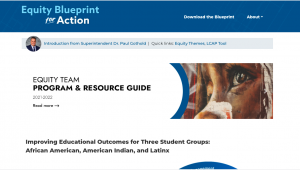
Kids in a classroom. (Photo: Shutterstock/Syda Productions)
The ‘Equity’ Passthrough: The Roles of County Education Offices
Is it legal or ethical to move money from the local school district to the county office of education?
By Wenyuan Wu, May 23, 2022 1:45 pm
2021 saw the beginning of an organic, parent-led movement from bottom up that exposes, scrutinizes and challenges the public education bureaucracy for imposing political ideologies on their children. Concerned parents are showing up to local school board meetings to demand accountability and transparency. They are showing up at ballot boxes to help elect those who echo their battle cry for true education, against indoctrination. Increasingly, everyday Americans are equipped with the knowledge and facts of the current culture war, instituted by a disengaged bureaucracy preoccupied with race and gender, supported by a multi-billion-dollar industry committed to peddle the lies of diversity, equity and inclusion (DEI), and waged by an army of foot soldiers on the ground.
While key decisions for curricula implementations and extracurricular programs are made at the local school district level, it is imperative to examine the often-overlooked roles of educational offices at the county level. These education offices promote opportunities to the county’s most vulnerable, provide guidance to local school districts and wield tremendous influence over the local education landscape. They also receive considerable public funds for the chief purpose of educating students with disabilities, those in foster care, at-risk youth, and students in juvenile detention.
For example, Los Angeles County Office of Education (LACOE), serving California’s largest county, has an annual revenue of over $743 million and a per student expenditure of $181,573. For the 2021-22 school year, the LACOE School District manages 42 public schools with a total of 8,062 students who are mostly in need of special education programs or remedial lessons. The district also supports former students in transition from juvenile detention back to their schools and communities.
In reality, rather than improving educational outcomes for special-needs students in the counties, these powerful institutions serve as de facto passthroughs for the transmission and dissemination of ideological agendas.

The San Diego County Office of Education (SDCOE), which commands a $499 million yearly income in California’s second largest county, serves 10 public schools in San Diego directly, assists the county’s 42 local school districts, and participates in “state and local policy meetings to support and advocate for the needs of local districts.” In recent years, SDCOE’s focus has shifted to “Equity,” the details of which can be found in its “Equity Blueprint for Action.” According to the blueprint, the district is dedicated to improving educational outcomes for three student groups: “African American, American Indian, Latinx.” The equity agenda is then distilled down to local school districts through partnerships and guidance for incorporating equity-based elements in their Local Control and Accountability Plans (LCAP). The key components of the equity blueprint are: “multi-tiered systems of support, socially conscious leadership and data systems.”
SDCOE has been successful in lobbying local school districts to expend large amounts of taxpayer funds in advancing equity. My research indicates that San Diego Unified School District, the largest district in the county, approved a $112 million LCAP for the 2021-2022 academic year which includes $85.65 million to “cultivating inclusive, Anti-Racism and restorative schools, classrooms and district – with Equity at the core.” For San Dieguito Union School District, its number 1 goal in the 2021-2022 LCAP is to promote “equity and access,” commanding $193,000 of local funding. Among the equity budget is a $34,000 item called “Equity work with SDCOE.” National Elementary School District, a severely underperforming district with a 32% math proficiency rate and 78.5% of students eligible for free and reduced-price meals, adopted a LCAP that put $2.4 million of local funding to “[p] rovide an integrated multi-tiered framework of support that incorporates differentiated instruction, social emotional learning, and positive behavior intervention to improve individualized student outcomes.”
In all cases, massive amounts of local control funding have been grafted to fulfill the dubious “equity agenda” under various code names such as restorative justice, anti-racist teaching, culturally relevant pedagogy, social emotional learning, and so on.
A more debatable activity regards funds transfer between local school districts and the county office. Public records requests show that Carlsbad Unified School District (CUSD) is paying SDCOE $15,000 for a one-year equity partnership so that CUSD employees can develop equity mindsets and skillsets to explore topics including “identity…implicit bias, micro-aggressions, privilege, systems of oppression, culturally responsive teaching… liberatory design.” SDCOE has also implemented a series of equity professional development courses in Oceanside Unified School District (OUSD), where restorative site teams partner up with the county office to “acknowledge OUSD is a safe place for students… (and ensure) LGBTQ students have supportive spaces on each campus.”
The relevant question is whether or not it is legal or ethical to move money from the local school district to the county office of education, given that both entities are funded by federal, state, and local public funds. In other words, does this constitute a grift?
A looming issue behind the agenda-driven advocacy work by county education offices, as exemplified by SDCOE, is the persistent academic underachievement in schools under their direct supervision. Only 9% of the students in Orange County Department of Education School District can do math at the grade level and the reading proficiency rate stands at a meager 13%. In Riverside County Office of Education School District, only 2% can achieve math proficiency while 28% graduate with high school diplomas. If these agencies can’t perform their full-time job of helping vulnerable students achieve literacy, why are they venturing into moonlighting for the equity crowd? The public needs to pay attention.
Table: Financial and Academic Overview of County Offices of Education in California’s Five Largest Counties
|
County Office |
Annual Revenues |
Expenses per Student |
Academic Proficiency in County School District |
|
Los Angeles County Office of Education |
$743,247,000 (38.1% Federal, 31.6% State, 30.4% Local) |
$181,573 |
-Math: 31% -Reading: 46% -High school graduation: 48% |
|
San Diego County Office of Education |
$499,617,000 (17.5% Federal, 51.6% State, 31% Local) |
$181,188 |
-Math: 3% -Reading: 13% -High school graduation: 24% |
|
Orange County Department of Education |
$312,103,000 (15.2% Federal, 20.8% State, 64% Local) |
$69,910 |
-Math: 9% -Reading: 24% -High school graduation: 34% |
|
Riverside County Office of Education |
$338,020,000 (9.6% Federal, 39.3% State, 51.1% Local) |
$150,643 |
-Math: 2% -Reading: 9% -High school graduation: 28% |
|
San Bernardino County Office of Education |
$418,179,000 (18.1% Federal, 53.1% State, 28.8% Local) |
$149,739 |
-Math: 2% -Reading: 7% -High school graduation: 27% |
- Legal Advocacy Stops a Racially Exclusionary Scholarship at UC San Diego - October 30, 2025
- Gavin Newsom Supporter Tells Chinese American Activists to ‘Go Back to China’ - October 24, 2025
- Fighting White Supremacy Once Again, Ku Klux Klan Act is Challenging Race-based Scholarship at UCSD - August 4, 2025





Wenyuan Wu is providing valuable information on how the educational bureauracy implements their “equity” agenda propaganda. As Wenyuan pointed out, parents need to hold county education offices accountable for having spent massive amounts of funding to promote their equity agenda under various code names.